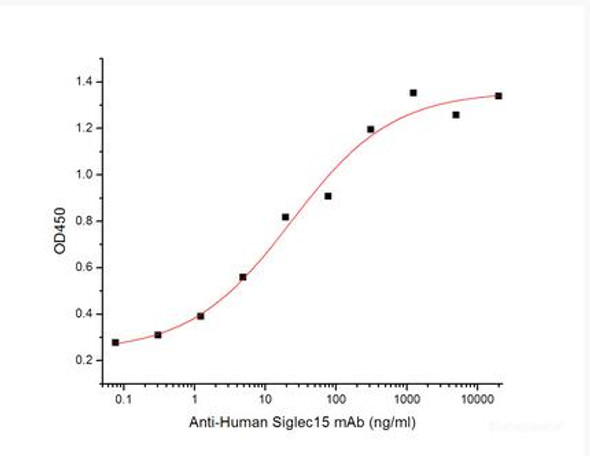Description
| Product Name: | Recombinant Cynomolgus Sialic acid-binding Ig-like lectin 15/Siglec-15/CD33L3 (C-Fc) |
| Product Code: | RPES6784 |
| Size: | 10µg |
| Species: | Cynomolgus macaques |
| Expression Host: | HEK293 Cells |
| Synonyms: | Sialic acid-binding Ig-like lectin 15, Siglec-15, CD33 antigen-like 3, CD33L3 |
| Mol Mass: | 53.1 kDa |
| AP Mol Mass: | 55-70 kDa |
| Tag: | C-Fc |
| Purity: | > 95 % as determined by reducing SDS-PAGE. |
| Endotoxin Level: | < 1.0 EU per μg of the protein as determined by the LAL method. |
| Bio Activity: | Immobilized Cynomolgus Siglec-15-Fc at 2μg/ml (100 μl/well) can bind Anti-Human Siglec15 mAb. The ED50 of Anti-Human Siglec15 mAb is 20.9 ng/ml. |
| Sequence: | Phe20-Thr263 |
| Accession: | A0A2K5UY47 |
| Storage: | Generally, lyophilized proteins are stable for up to 12 months when stored at -20 to -80°C. Reconstituted protein solution can be stored at 4-8°C for 2-7 days. Aliquots of reconstituted samples are stable at < -20°C for 3 months. |
| Shipping: | This product is provided as lyophilized powder which is shipped with ice packs. |
| Formulation: | Lyophilized from a 0.2 μm filtered solution of 50mM Tris-HCl, 100mM Glycine, 150mM NaCl, pH 7.5. Normally 5 % - 8 % trehalose, mannitol and 0.01% Tween80 are added as protectants before lyophilization. Please refer to the specific buffer informati |
| Reconstitution: | Please refer to the printed manual for detailed information. |
| Background: | Siglec-15 is a transmembrane glycoprotein in the Siglec family. Siglecs are type I transmembrane proteins where the NH3+-terminus is in the extracellular space and the COO−-terminus is cytosolic. Each Siglec contains an N-terminal V-type immunoglobulin domain (Ig domain) which acts as the binding receptor for sialic acid. These lectins are placed into the group of I-type lectins because the lectin domain is an immunoglobulin fold. All Siglecs are extended from the cell surface by C2-type Ig domains which have no binding activity. Siglecs differ in the number of these C2-type domains. Siglec-15 function is important for osteoclast formation and TRANCE/RANK Ligand signaling in osteoclasts. |






